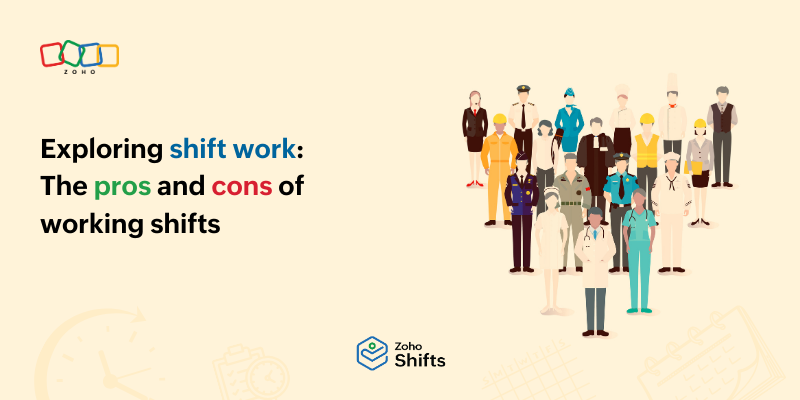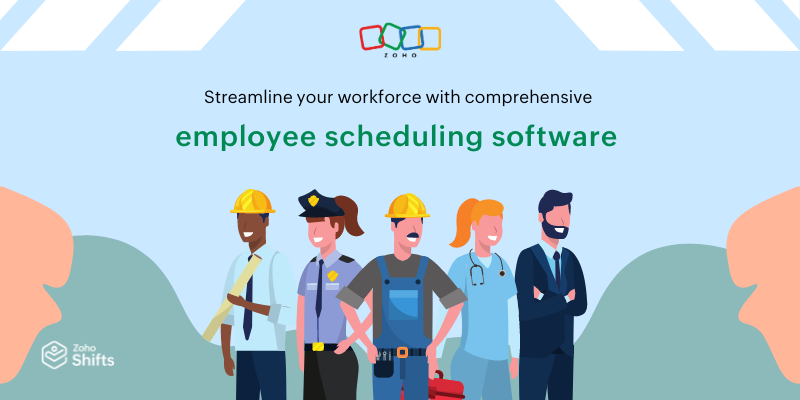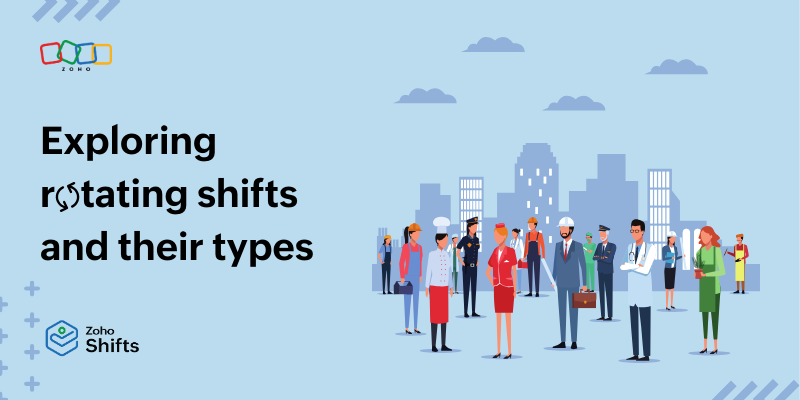- HOME
- Shift Scheduling
- Exploring shift work: The pros and cons of working shifts
Exploring shift work: The pros and cons of working shifts
- Last Updated : October 5, 2023
- 2.8K Views
- 5 Min Read

Many companies around the world operate during the traditional hours of 9 am to 5 pm. If businesses need to stay open for more than 12 hours, chances are they will need to use shifts. Industries that we interact with regularly like healthcare, retail, hospitality, and more follow shift work. By adopting shift work for employees, organizations can be adequately staffed and can operate around the clock to serve their customers while ensuring fair working hours and rest periods for employees.
Why is there a need for shifts?
Shifts have become common for businesses that operate for more than 10 hours a day. They can prevent employee burnout, maximize productivity, help the employer split up work, and ensure clocked time stays under 40 hours per employee each week.
By switching to shifts, you can cater to various employee needs. Most employees are looking for work-life balance, and the recent popularity of remote work made it even more important to draw the line. With the option to choose their schedules, employees can directly improve workplace productivity.
Implementing shifts has much more importance in some industries. Restaurants and some retail stores operate for extended hours. Dividing the work into shifts can help ensure employees perform to the best of their ability.
Types of shifts
The type of shifts and the nature of the work hours vary from one organization to another. We can, however, classify shifts based on timings alone into three categories:
First shift: The early bird
The morning shift, the first shift of the day, and the usual 9 am to 5 pm. This is the standard time that comes to everyone's mind when we think of work. This is the time most people are awake and when companies need the maximum number of employees on staff.
If the nature of your business is to operate during regular business hours, it is still important to set up schedules based on employee preferences.
Jobs that commonly use the first shift: Sales, human resources, administrative jobs, and customer service
Second shift: The swing shift
The second shift is almost like an intermediate shift between the first and the third shift. More often than not, the timings tend to overlap with the first and the third shift. The common swing shift timings are between 4 pm and 12 am. While the exact time slot may vary from one second shift to another, the shifts tend to end before midnight.
Jobs that commonly use the second shift: Retail, call centers, flight attendants, and bartenders
Third shift: The night owl
Popularly referred to as the graveyard shift, the third shift has employees work through the night into the early morning. A third shift typically starts closer to midnight and goes until 7 am or 8 am. This shift is commonly associated with businesses or services that need to operate around the clock and should have staff available at all times.
Jobs that commonly use the third shift: Police officials, paramedics, security guards, doctors, nurses, and hotel managers
The pros of implementing shifts
Implementing shifts in the workplace comes with some benefits. With businesses working for longer hours, overall productivity and output are higher than ever before. Here are some benefits of shift-based work:
Option to avoid peak hours
Commuting daily to work can be difficult for employees, especially with the amount of traffic on the roads during the peak hours. By opting to work on a shift outside of the traditional 9 am to 5 pm time slot, people can commute to work without the added stress of traffic and the noise that comes with it. This is especially beneficial for the employees who are working the third shift.
Added financial benefits
Companies know there's a need to incentivize night shifts to make it an attractive option. They usually offer increased wages, and the night shift can even offer increased chances of career growth and promotions.
Manageable workloads
When companies operate using shift work, there are higher chances for them to look to reduce overtime costs. Since there is always someone always coming to fill in after an employee's shift is done, the need for employees to stay late and finish work is drastically reduced. Shift work also gives employees the option to work fewer days a week. For instance, an employee can finish a 40-hour work week in four days and enjoy a longer weekend. Working in shifts gives that flexibility to the employees.
The cons of implementing shifts
While companies can reap the benefits of longer workdays, there are challenges for the employees that work these shifts. Here are some of the downsides of implementing shift work:
Unusual routines
Most employees are accustomed to a certain pattern: Start the workday in the morning, break for lunch, and leave the office by the early evening. Constant changes to their shifts can disrupt routines and make it difficult for employees to adapt.
Lack of a social life
For employees who value frequent social interactions outside of work, the night shift may not be the best option, especially since most social gatherings are in the evenings. Staff working the second or third shift will likely have to miss all of these events. This can make it difficult to have a fulfilling social life.
Unavailability of resources
Staff on the night shift do not have access to the basic resources that are available during the day shift. Employees do not have access to most public transport at night. While the lack of traffic is beneficial to people owning a vehicle, it can be a problem for others. In most cases, places to purchase food locally are not available for staff after midnight.
Feeling disconnected from the workplace
Even if there is someone to supervise the night shift, there is a tendency for the shift workers to feel isolated from other members of the organization. This is because the majority of employees work the day shift. Even if night shift employees want to talk to upper management or the human resources department, they will have to wait for the day shift hours to do so.
Health and safety concerns
In the process of constantly working alternate shifts, employees can experience issues with sleep, digestion, and blood pressure. Working in shifts can disrupt a person's daily rhythm. This inconsistency with sleeping and eating times can take a toll on the body and cause issues in the long term.
Personal issues
Working in shifts can impact families, especially when individual family members work at different times of the day. When they are not home at the same times, it can strain relationships and cause rifts within the family. This problem is more pronounced if there are children with parents working different shifts.
Conclusion
When it comes to shift work, there are various ways to schedule employees. While it can solve many problems, it does come with its fair set of challenges. It can often become difficult to balance the needs of the business and the availability of staff. While drafting shifts, it is important to avoid over-staffing or under-staffing while keeping overtime costs to a minimum. Balancing the morale and well-being of the team and your business goals can help contribute to the overall success of the company.
Organizations that operate for long hours each day rely on shift work. An employee scheduling software like Zoho Shifts can help them save time, maximize business productivity, and achieve greater efficiency.

